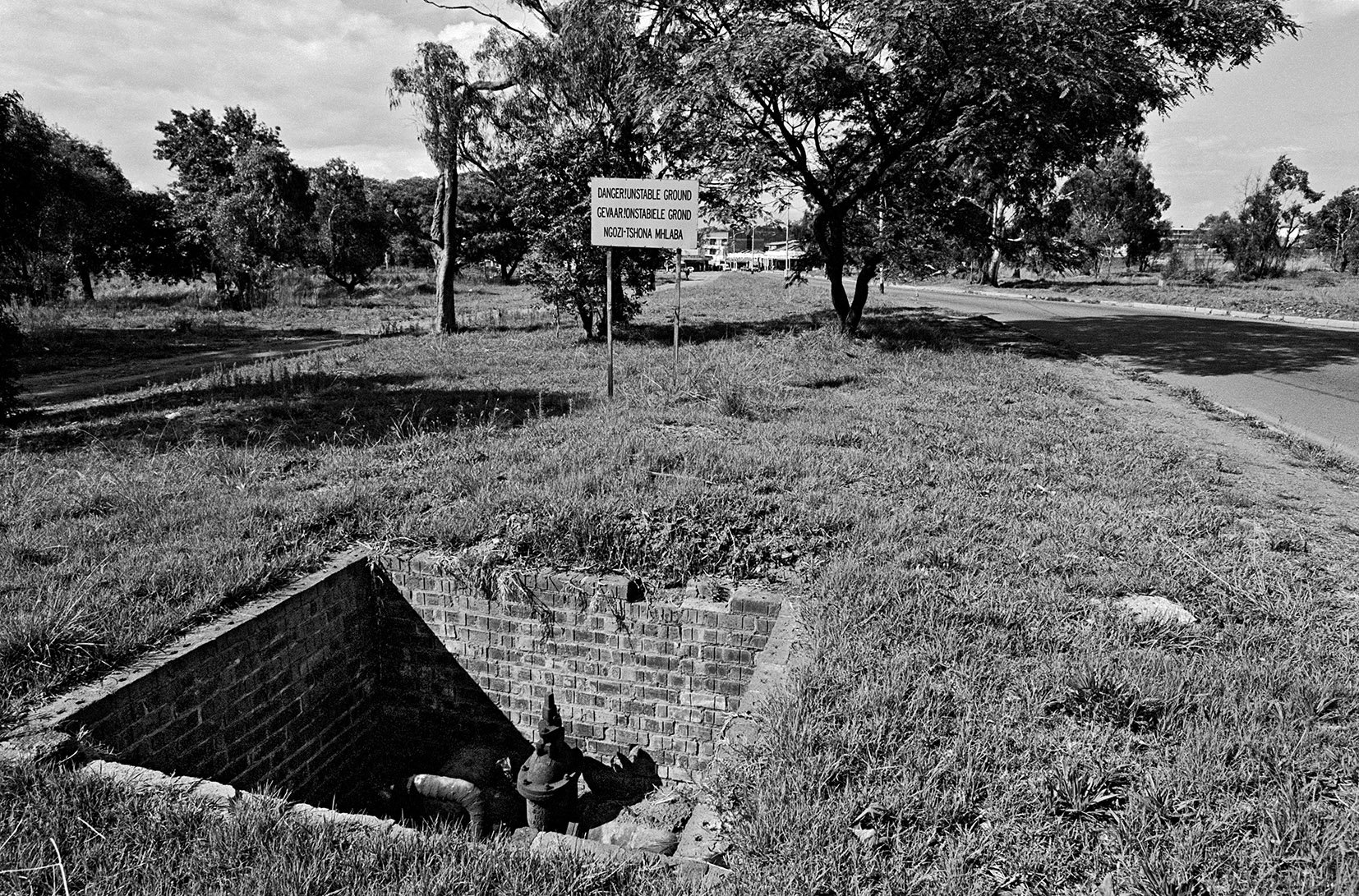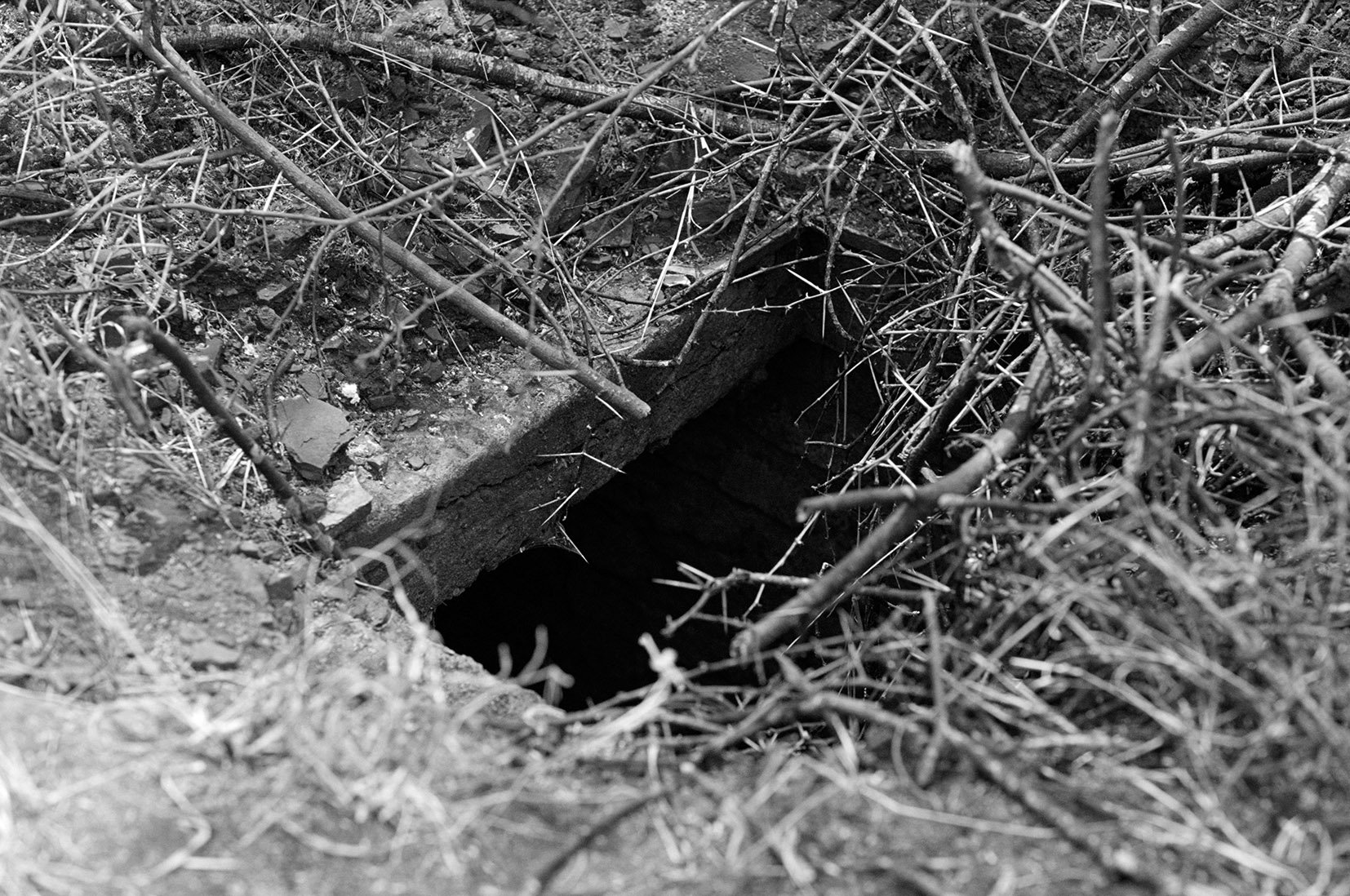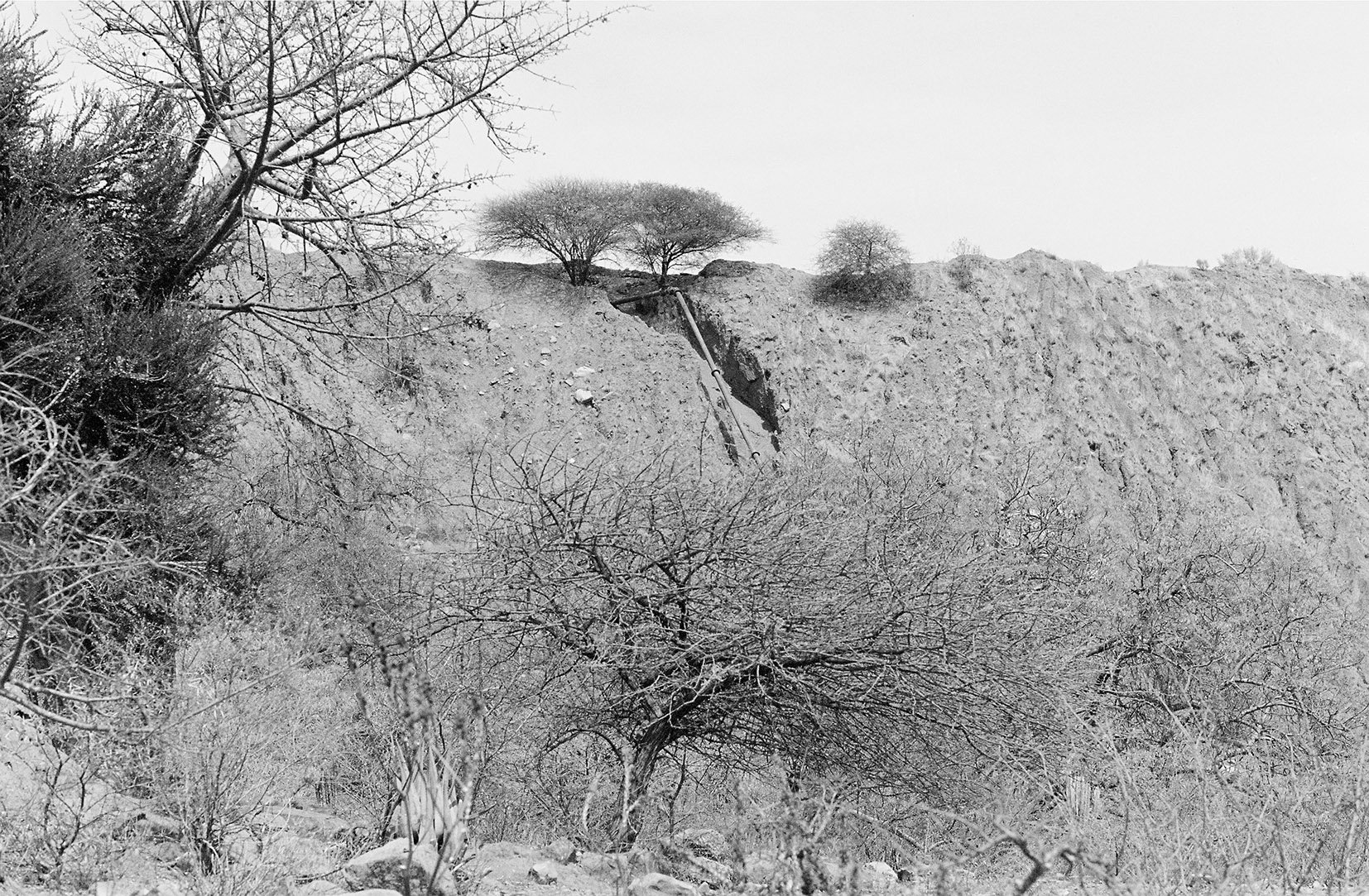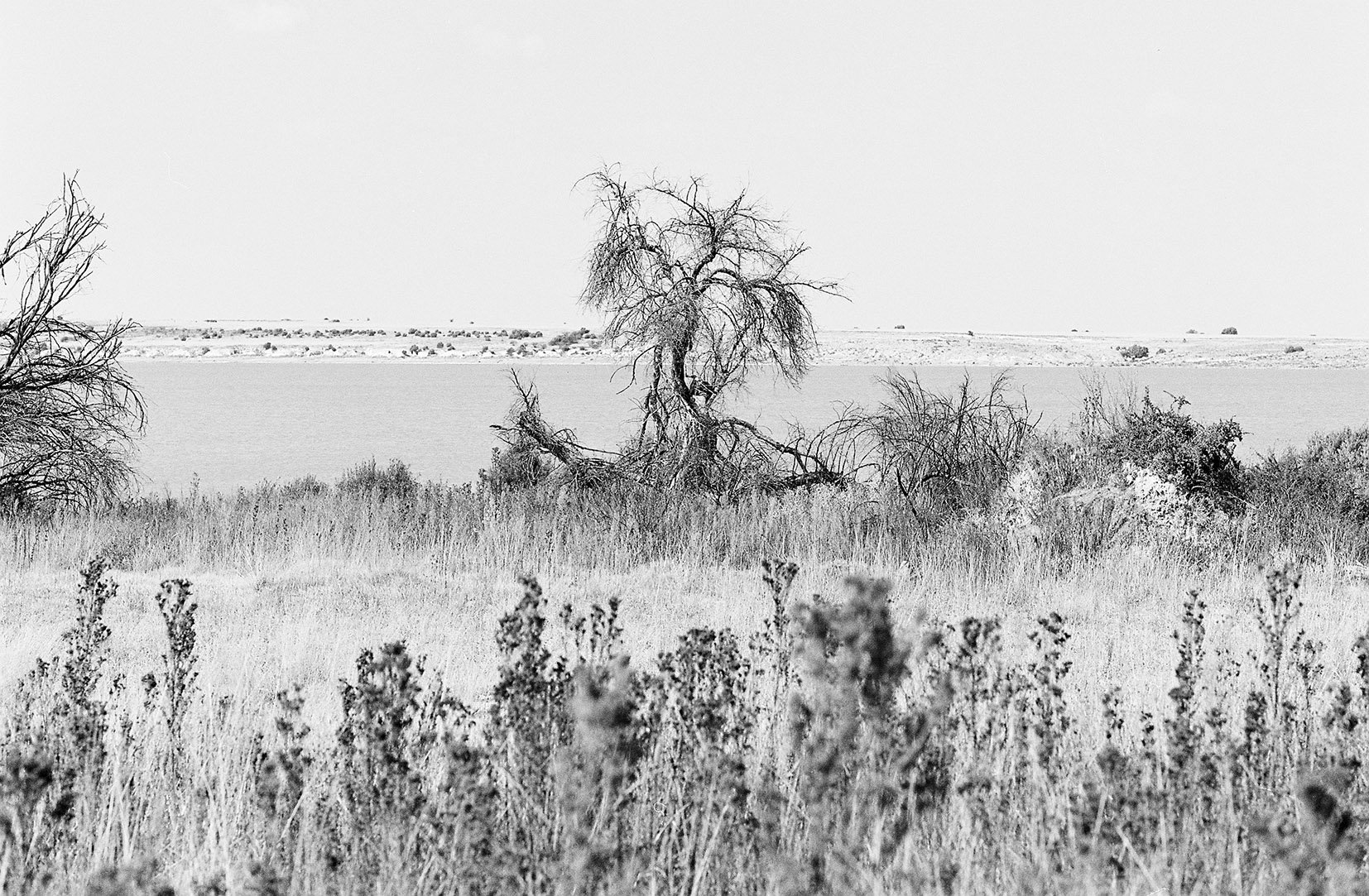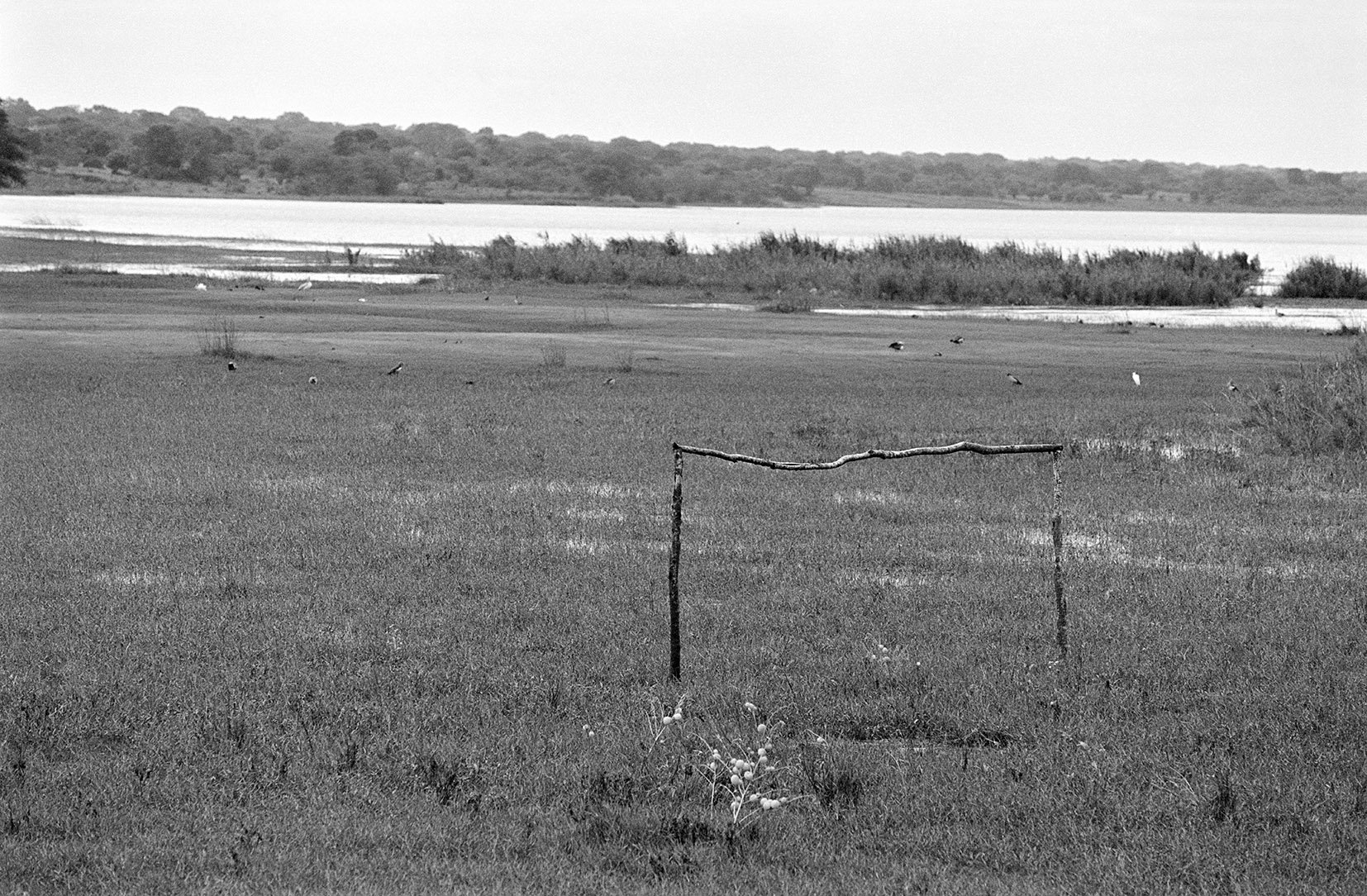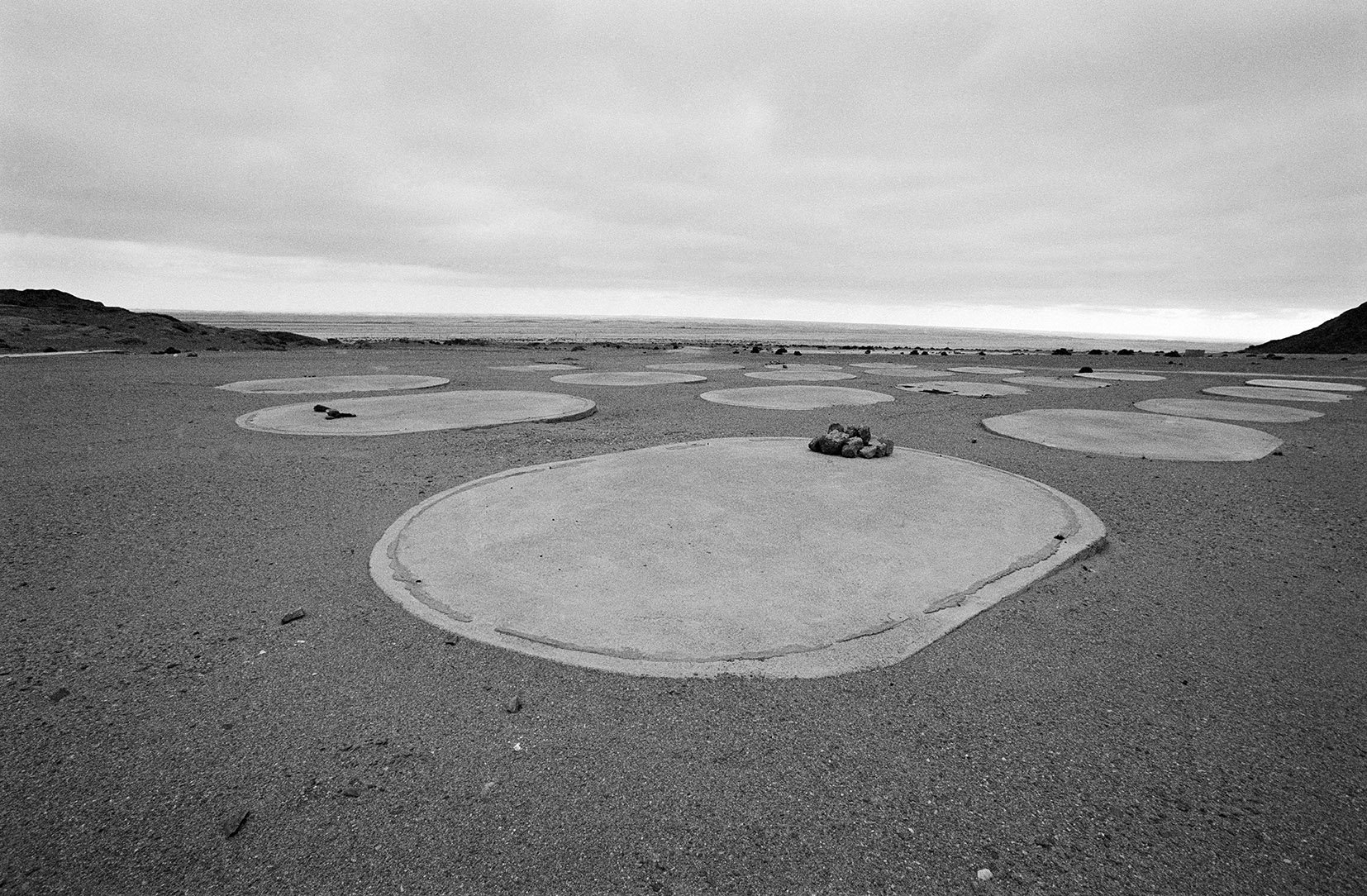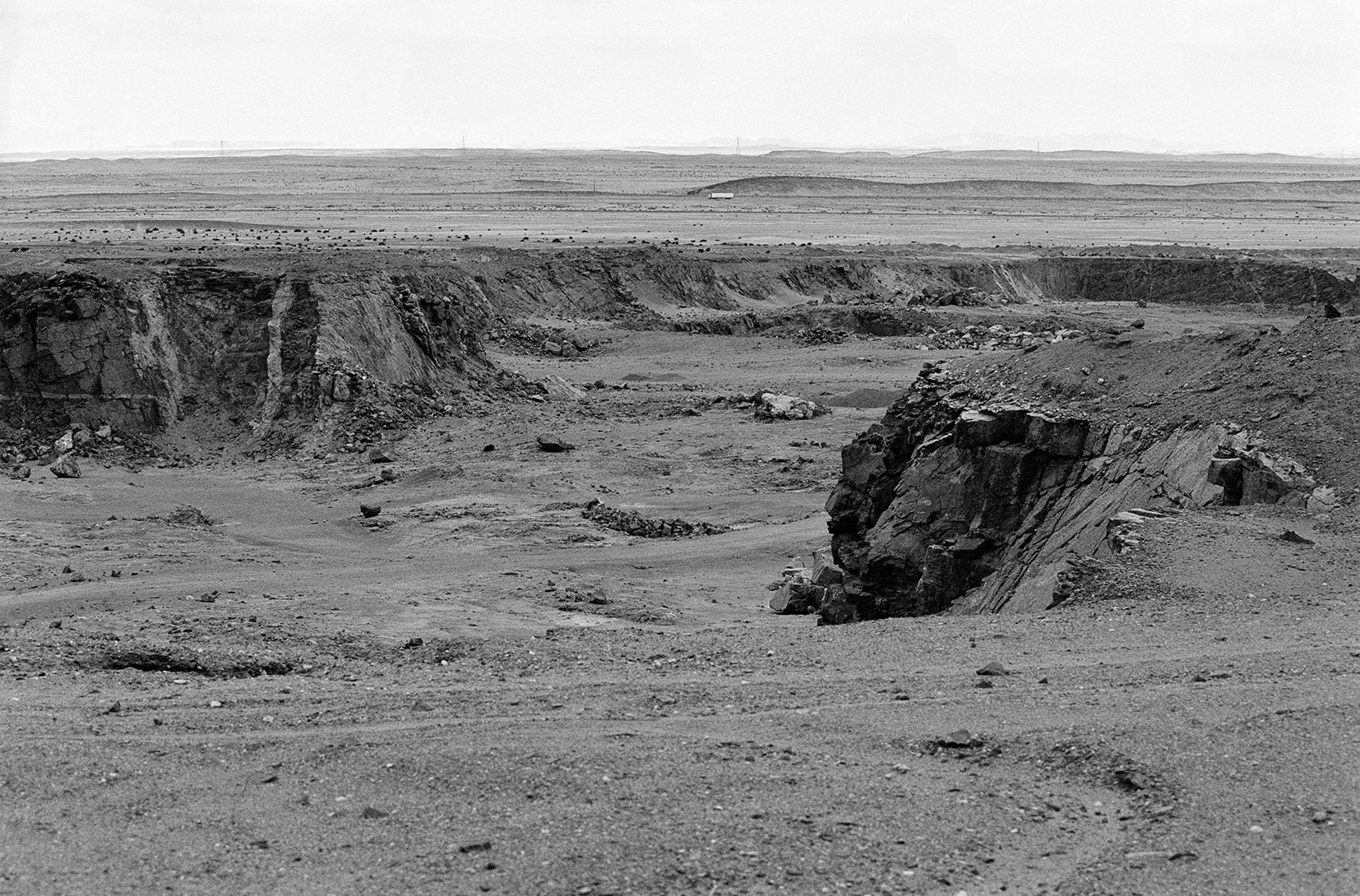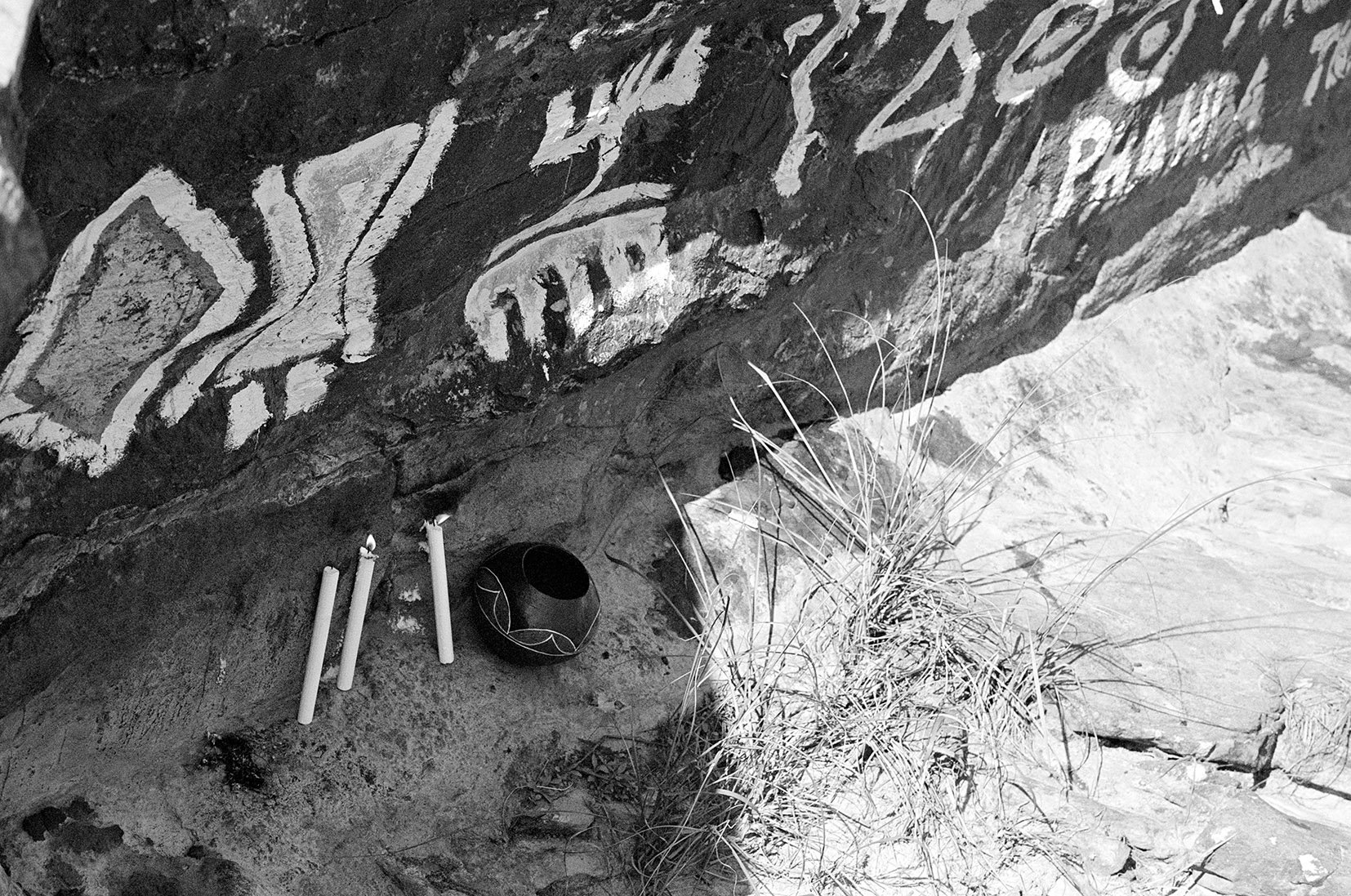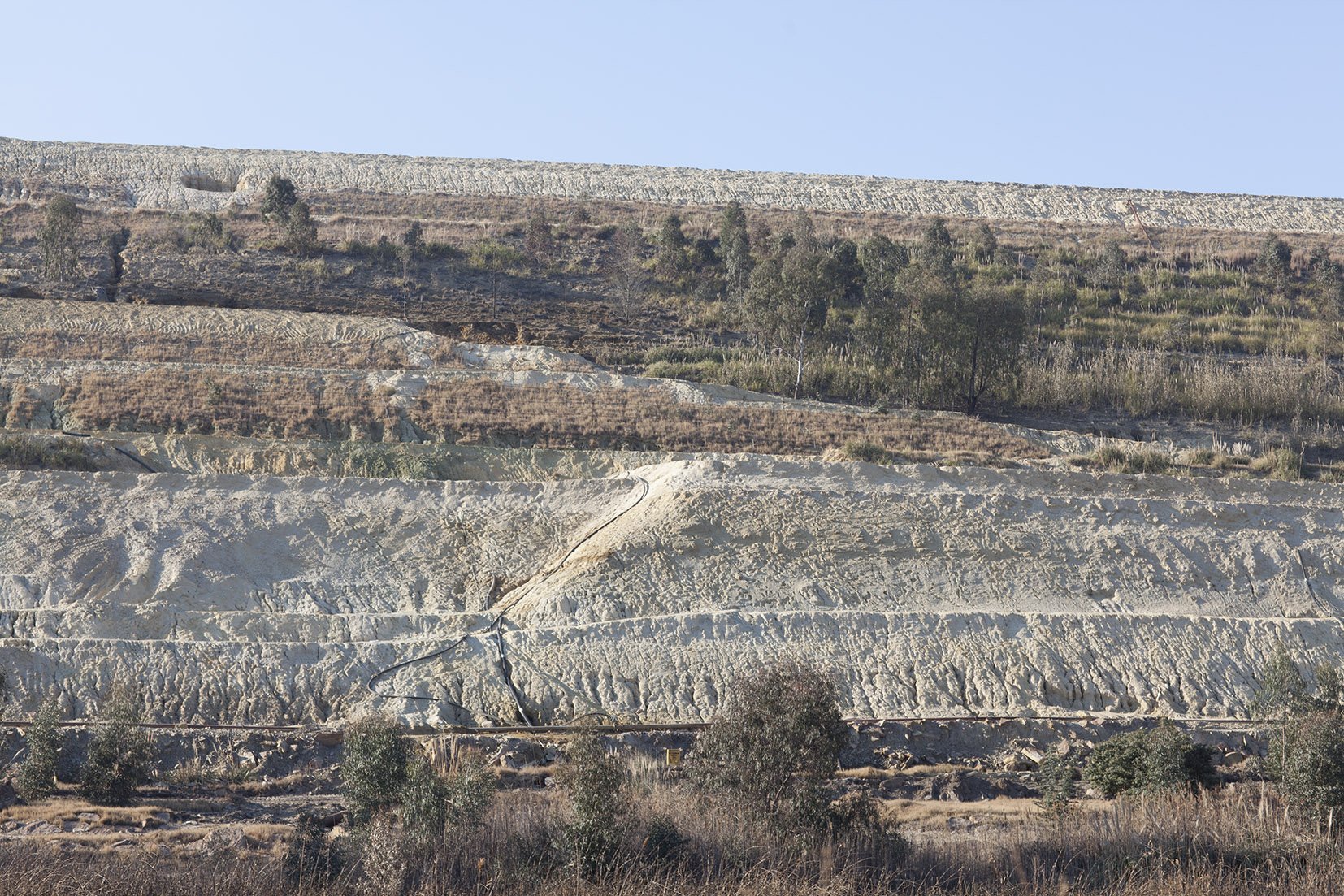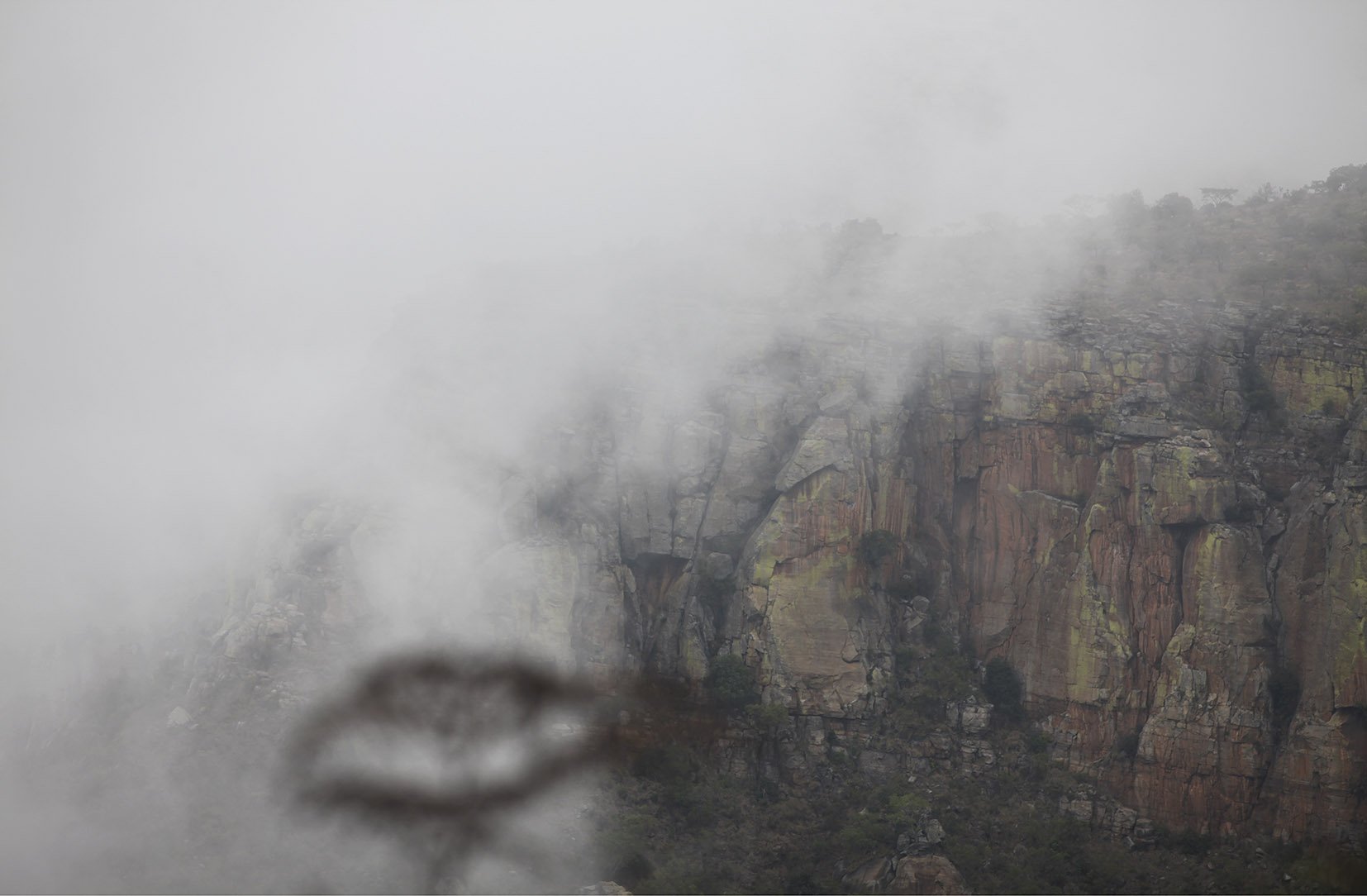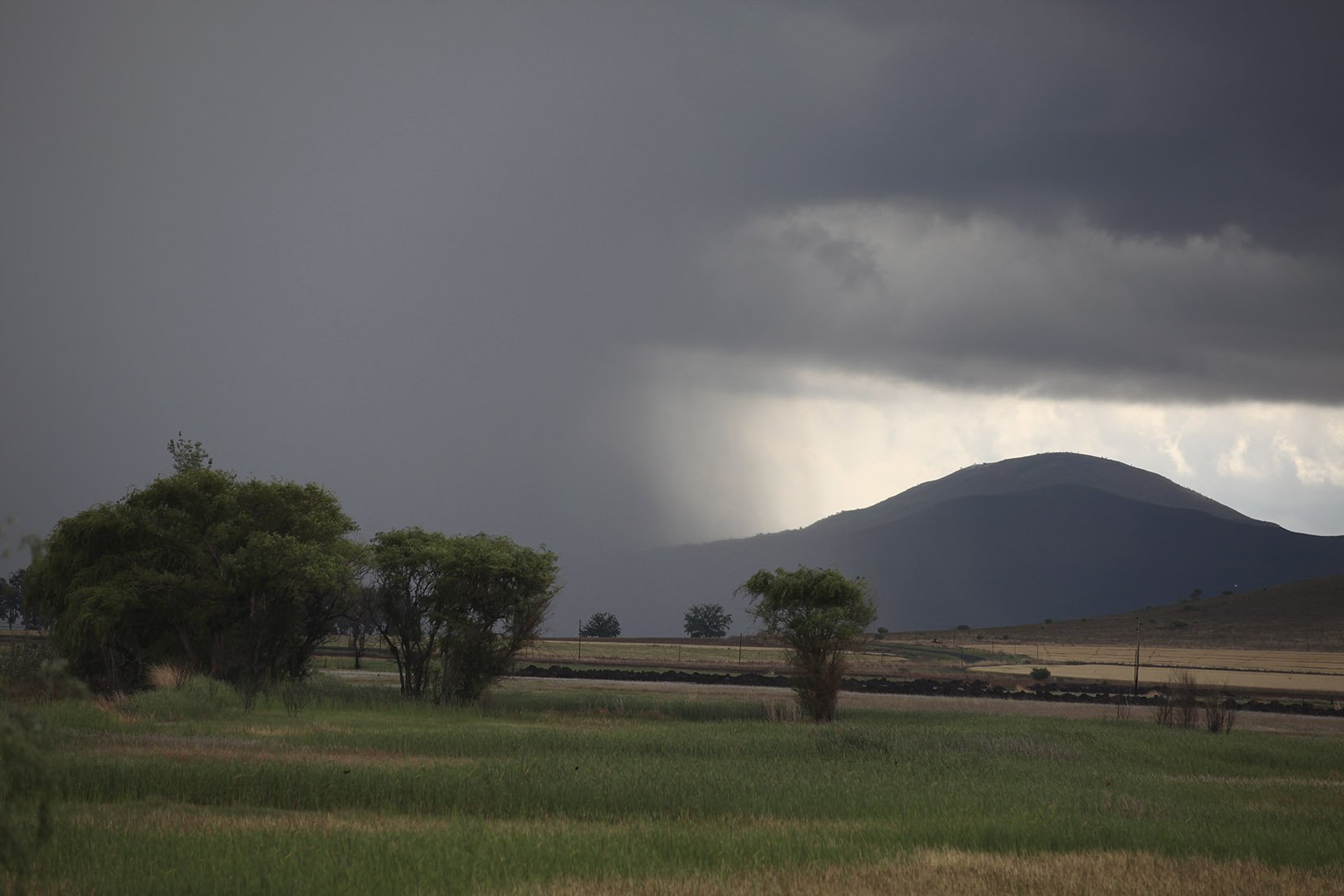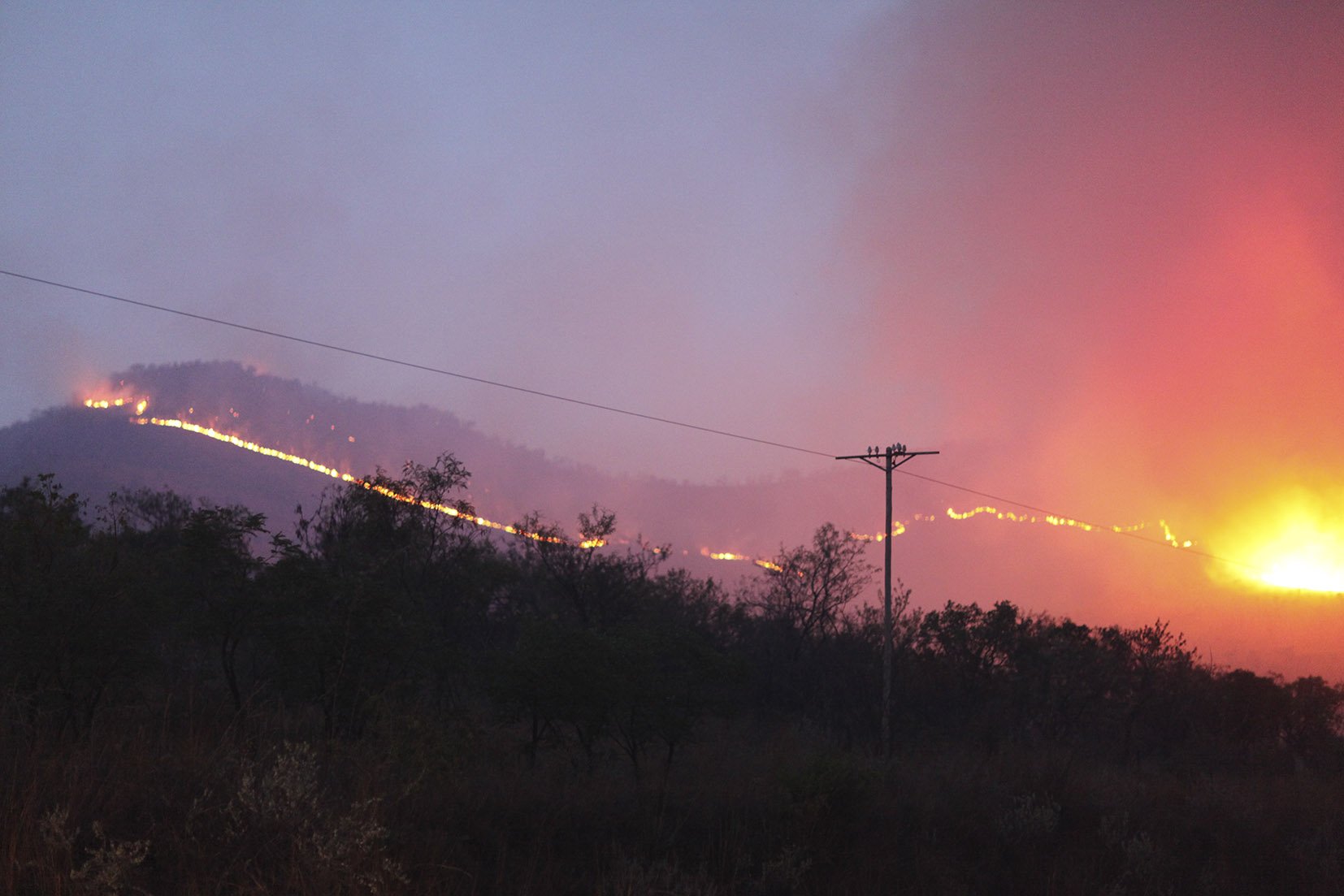Poisoned Landscapes
Poisoned Landscapes
Later, its form will come to light like a developed photograph.
I. Notes from underground
What forms are coming to light? What latent signs are emerging? In Memoirs of the Blind Jacques Derrida speaks of writing in the dark. ‘But for now, at this very moment when I write, I see literally nothing of these letters’. In straining towards these letters, the writer feels the barriers of the senses break down. The parallel he draws is with photography.
Santu Mofokeng is drawing out a seepage, a leakage into light, of processes happening in and on the earth. Things are coming from underground, crystallizing the uncanny, often as slow encrustations and cancers. At the centre of this despoliation is Johannesburg, the city of gold, a concrete encrustation in itself. In the convergence of industry, environment and photography, I think of Kracauer’s flat claim for the medium: ‘The photograph captures only the residuum that history has discharged’, he says. ‘The photograph is the sediment that has settled’.
I caught Mofokeng recently outside a Johannesburg gallery after a public discussion between a novelist, a photographer, and a philosopher. He tells me that the photographer David Goldblatt put his finger on a crucial difference between them. ‘I’m excited by the existence of things’, Goldblatt had stated. ‘Is-ness’. By contrast, says Mofokeng, he likes ambiguity. ‘This comes from a position of helplessness, not authority’.
For many years Mofokeng has worked on the boundaries between the material and the immaterial. This means that sometimes the material shades into the immaterial, and vice versa. In his recent work on climate change, there is a new set of boundaries. These are between the elements: water, earth, air and fire. It is at their points of contact that the poisons emerge, forming crusts, or a liquid sheen, or dust motes, like evidence of disease, symptoms of what has been happening for a long time: sediment. Suppurations arise from the residues of the primary industries that made South Africa modern ahead of all the African continent. These melancholy productivities made a migrant labour force, a working class, a bourgeoisie, landscapes, cities, empires, over the last century.
On the face of it, much of Mofokeng’s photography on ‘climate change’ brings together political economy, social documentary and environmentalism in South Africa. Every history of Johannesburg reads that the gold-bearing beds are the origins of the metropolis. Under an initial kind of wild capitalism and with gold close to the surface of the reef called the Witwatersrand, the city started in 1886 as a series of uncontrolled mining camps. In the next phase of mining development, the steep dive to the next layer or strata made it necessary to sink ‘new shafts from positions well south of the original outcrop mines and to reach the ore-bearing seams by complex systems of tunnels and passageways, drives and stopes’. In their time these became the deepest mine shafts in the world.
Thus there is the city and its underground. But we have to get away from the bounded paradigm of ‘the African city’ into which Johannesburg is now inscribed. The city has its industrial and demographic scatterings that lie far from the metropolitan hub, which the mining economy and apartheid development policies linked together in one system that incidentally lacks an obvious vocabulary. The city sprouted on the gold mines of the Witwatersrand, but the Witwatersrand (now partially exhausted) is but one part of a chain of mineral possibilities. Thus the hollow ground under the photographer’s feet is not just the city, even though the growing sense of panic over South Africa’s mining legacy takes a very urban form. One recent newspaper report for example highlights that ‘South Africans are fearful that Johannesburg may soon be at the mercy of acid water, with whisperings of the CBD (central business district) crumbling as basements flood and buildings corrode’. Downtown Johannesburg is in fact very close to the earliest mining enterprises, built over shafts that were dug into sites whose ground water was pumped out to enable mining. These are now voids and filling up once again with water: the ‘white waters’ of the Witwatersrand.
A series of articles on environmental issues has appeared in the national weekly Mail & Guardian, specifically on South Africa’s mining legacy. These often focus on Acid Mine Drainage (AMD), which is elsewhere called acid rock drainage because of the more generalized conditions in which it occurs. Acid mine drainage arises when the runoff from mine dumps and the decant from abandoned mines carry sulphurous metal traces that undergo chemical transformation to become acidic. These do not support regular life forms. The massive voids created by a history of shaft-sinking, with over 6000 disused mine sites in South Africa, implies that the problem will increase exponentially.
The emerging debates on AMD are tangled and contentious, allegedly representing ‘a wide variety of fact and fiction’:
AMD involves an elusive and complicated mass of overlapping, incorrect or incomplete data, personal politicking marked by oft-interchanging vendettas and alliances and an environment pockmarked with racial prejudices, the unpredictable demands of the international market, foreign exploitation, and a broken political, legal and managerial landscape fuelled by apartheid and encouraged under the democratic government.
This is not just about water. And nothing is as it seems.
The last statement echoes the kind of sentiment Mofokeng himself often utters, whether in relation to photography, or to climate change. ‘It’s not about certainty,’ he says to me. ‘It’s always been about not knowing’. Finally, ‘It’s OK. It’s OK to doubt’.
It is striking that the newspaper revisits the notion of a ‘broken landscape’. This metaphor of rupture has circulated in the literary and photographic discourses of the country for a long time. It originates in H.I.E. Dhlomo’s poem, Valley of a Thousand Hills, which laments the loss of older African social harmony with nature and the emergence of ‘multi-layered dispossession’ based on the ugliness of the capitalist system. He writes of ‘a future tragic with Greed’s ways’ and the ‘broken people of the land.’ In Dhlomo’s ‘dark present’, it was already ‘the Wrong-torn land’.
He writes: ‘Erosion sweeps men’s souls to sea … A fog of tribulation spreads’. This was in 1941. In the scientific envisionings of AMD, experts go as far back as the pre-mining landscape in order to explain the violations of modern deep-level mining, and the trauma signified in the post-mining landscape with groundwater re-filling the pumped out voids of mine shafts and the chemical processes producing acid. As the water seeks its way out after being disturbed for so long, it refills these voids and now decants on to the surface. In the Witwatersrand, decant started in the Western Basin in 2002 and resulted in the contamination of nearby Robinson Lake, and is expected to happen in the Central Basin in 2012. The theme of hollow ground, of forgotten pipes of stripped wealth and burrowed out passages under our feet, and the slow rise of acid mine drainage to the surface in recent years, ironically reconnects South Africans to the ground under their feet, after a long ‘psychic rupture with the land’. But this ground under their feet seems to be subsiding, with toxic liquids welling up inexorably and contaminating the sources of water. Apartheid, dispossession, urbanization, are not the end of the story of this land.
The attempts by the post-apartheid government to mend the broken landscape through re-entitlement and restitution with the new Reconstruction and Development Plan (RDP) housing projects for example, point to sites of gross exploitation and pollution into which aspirant urban residents are often placed. They come with dreams of delivery, of expectations met, of upward social mobility. The new landscapes however are raw and exhausted at the same time, full of old political poison. ‘The blades of grass are blades of grief’. Those are the terms of development and upliftment. The state delivery is a bald one. In not addressing these choking problems, did we know the invoice after apartheid included this mounting cost? Mofokeng’s work suggests that we have moved from broken landscapes to poisoned landscapes.
Existing conventions critique apartheid and capitalism. Some go further to say the surface of the earth is ‘frequently associated with provisionality and repressed meaning’. But what lies under the surface? There are more repressed meanings than just the labour question and white or capitalist guilt. Thinking of the underground, Dostoevsky chose this idiom as a site of psychological torment, distortion and festering. Here dwells the man of ‘acute consciousness’ and inertia, whose liver gives him pain, as if his body has not been able to process the toxins coming out of what he has consumed and must consume. In South Africa, is the disempowered figure of black labour, like Dostoevsky’s man from underground, ‘in that hell of unsatisfied desires turned inward’? Does he too work up ‘a sort of fatal brew, a stinking mess, made up of … doubts, emotions, and of the contempt spat upon … by the direct men of action who stand solemnly about … as judges and arbitrators’? And if so, will this continue?
Mofokeng offers his own notes from underground. Some photographs take us to the holes at Penge, the gaping black mouths of disused mine shafts. If there is any humanism, any attempt to get at the thoughts and feelings of those who have been penned up below, it is only a hint. His photographs suggest a breakdown in the codes of signification in South African photography that internationally is associated with a struggle against a more obvious oppression, or more recently, the exploration of new post-apartheid subjectivities and sexualities. Mofokeng however remains a documentarist. Following this tradition, he does not reveal himself. He remains as invisible as some of his subject matter. And while photographic thematics often emerge as a result of political, economic or pressure group forces, there is a philosophic force emerging inexorably from this work that is about aftermath – a more difficult aftermath to read than those associated with African conflict or post-conflict scenarios. This is all much more opaque, without humanist proximity or an obvious drama.
This is not to say that other dramas are not implicit. Penge is an asbestos mine on the Oliphants River in Limpopo province, shut down in 2002 with the recommendation that the site be closed to all human habitation. About 20 km away is another disused asbestos mine at Weltevreden, which by contrast has not been ‘rehabilitated’. This was the site of a death squad murder in 1989 recounted to the Truth and Reconciliation Commission. It is a space with two different kinds of aftermath: the violent and the toxic. Remoteness from the visibilities of the city have invited and later clouded these mournful episodes.
Despite the recommendations that Penge be closed to human habitation, it is being mined once again for its residual infrastructure and the recovery of pipes, cables, wires. It has resulted in new fissures in the ground, at the bottom of which can be seen the open veins of buried and severed pipes. In Mofokeng’s images, it is as if zombies had been at work in some kind of night economy that deals with the recycling of what is buried and which the bush has also been reclaiming. But this is just a recent trace. The older traces connect with well-known side effects of working and living with the invisible asbestos fibres that enter the lungs and take time (sometimes 40 years) to affect health. This is where the lapsed formal and secretive informal economies are in close relation to each other.
Mofokeng and other photographers have already alerted us to the apartheid script, where the detritus of capitalism washes up in the ghetto. Mofokeng’s earlier photographs of broken dolls and other strange objects give definition to the material spareness of township life, and things like lampposts conjure up intense memories of childhood. But the worst of the post-apartheid script is that the leftovers of modernity must inhabit these spaces such as Penge and elsewhere. The same goes for the RDP housing projects close to toxic runoff from mine dumps, or close to the voids of disused mines, those catacombs under the ground now filling with water and acid drainage. On the edge of a lapsed industrial phase, and just as their hopes were rising, residents must endure a sense of the ground subsiding beneath their feet. To quote one Davidsonville resident: ‘I live directly behind the mine dump and right next to the wetland… But it’s getting worse … the house is sinking’.
II. Envisioning climate change
The breaking of ground is a seminal moment. War is usually responsible for the ‘de-materialising world’. Paul Virilio recalls the World War 1 psychologist Lebon who argued that the fixity of the subject had depended on the fixity of the natural environment, but with ‘the relentless churning up of war’s landscapes’ this was fragmented and shattered. The implication is that it contributed to the breakdown of political and social systems.
The moment of replacing sand on Durban South Beach is paradigmatic for climate change because it is so visually definite. But the composition is such that the content becomes undefined if not unhinged: it is unclear whether the arc of sand is an irruption as from a volcanic bed, or whether it is cascading from the heavens. This is because Mofokeng has taken a divine position so to speak, God-like, where the source of the cannonading sand is hidden and the earth suggests planetary constellations and colliding energies. The viewer is confronted with seemingly centrifugal forces and things seem upside down. To quote again from the poet of broken landscapes: ‘The heavens rain hell from purest skies’.
These are moments reminiscent of Turner’s late work such as Snow Storm – Steamboat off a Harbour’s Mouth (1842), where the elements begin to melt into each other. Mofokeng’s dust storms also point to this blurring of horizons and confusion of vision. Such moments resuscitate older understandings of the contest between land, sea and sky, where ‘terrestrial boundaries’ are exceeded:
… the OCEAN, that expanse of water which antiquity describes as the immense, the infinite, bounded only by the heavens, parent of all things …the ocean which … can neither be seized not enclosed; nay, which rather possesses the earth than is possessed.
In his discussion of the way steam cut across weather in the 19th century, Allan Sekula says: ‘Turner’s exorbitation of the weather occurred at the very historical moment when it was widely imagined to be vanquished’. Sekula points to this as an anachronism in the relationship between weather and art. If so, what anachronism does Mofokeng produce? The heavens, ocean and earth would seem to be at war, attempting to possess the frame. This apparent exorbitation is made possible by obscuring the machine pumping out the flying sand. Regarding the rise of the industrial age, Sekula goes on to say:
The slum was for Engels what the storm was for Turner in his later paintings: a catastrophic limit set against industrial hubris. Their great difference lies in the fact that industry and the slum produce one another, while the storm remains an external force.
With Mofokeng the difference is that everything is now in a catastrophic relationship. The storm is no longer easily displaced as an external force; for here, industry and the storm have produced one another.
These South Beach pictures offer a defining moment of the replacement of sand. In other words, its problem is being addressed. Perhaps we should remember that this beach is a tourist and middle class space. But visually it provides the opportunity to make the entire notion of climate change more legible, arresting, even spectacular. Most of Mofokeng’s photographs about climate change do not do this. This begs the question, how do you see what is usually so difficult to see? How do you show the changing of rhythm in a landscape? It is about movement, some of it very slow.
III. Economy
South African photographers have dealt with land issues, and landscapes. But art history is inadequate to grasp the combination of arguments, politics and speculations that are coming together to explore what is called climate change. A discipline that is frequently neglected in thinking about documentary or humanist photography is economics, which is itself a discipline that emerged out of many different strands of thinking in the late 18th century. In looking at mining photographs in the colonial archive in Zimbabwe, Josiah Mhute coined the notion of ‘the capitalist gaze’ to critique the forces at work behind the ripping open of the earth in the search for wealth, and the ‘bastardisation of African culture’ that ensued in creating a labour force that then came under the productive and representational regime of ‘Southern Rhodesia’. But we need something more comprehensive than this. How one can envision ‘the economy’ that we speak of, which possesses ‘the destabilizing surplus of a desire blind to the whole and ignorant of its effects’.
It would seem that Mofokeng is addressing our blindness to the whole. We have bodies of work in South Africa that show the heroic labours of miners in dim claustrophic conditions underground, or dwarfed in scale by the mechanics of lift shafts and so forth, their faces vivid in the underground electric light. It is not easy to gain access but has been done, including by Mofokeng. Again, a strong social history tradition in South Africa and a radical critique of capitalism in the 1980s, fed into humanist and documentary photography. Mofokeng now seems to be going somewhere more opaque and difficult, to probe that latter-day blindness to the whole. The starting point in most pictures is the necropolis of the ‘first industrial divide’.
In global terms the first industrial divide is said to have occupied the first three quarters of the 20th century. Here continuous process machinery initiated the mass production of standardized goods, leading to economies of scale and corporate or managerial capitalism. These impersonal giant corporations were protected from competition and accountability, Are we looking at the ravages of these economies of scale in the South African mining landscape? Indubitably.
A favourite photographic theme globally has been the post-industrial carcase, producing a veritable fashion for ruins. But this is not where Mofokeng is.
The ‘second industrial divide’ features a ‘restructuring of capitalism characterized by decentralized production and changed technologies of flexible specialization’. This breaks out of the old hierarchical structures of managerial capitalism, and has a relatively small workforce. New mining in South Africa would theoretically take place under these conditions. To the extent that a second industrial divide applies, and together with the exigencies of ‘the market’, the huge labouring class - a product of the massive social upheavals warranted in making a subcontinental migrant labour system of men going underground to toil at the rock face, giving birth to compounds, townships, influx control, trade unions, political cultures and most of the features of the apartheid system - is made redundant. Generations of ripping out male labour, having at last succeeded in naturalising wage labour, urban life, migrancy, now has its raison d’être stripped away from it.
Everyone is there, filled with expectation, but for many there is nowhere to go. It is a legacy for the post-apartheid government to face. This transition (as opposed to the political transition) gives rise to high unemployment, impoverishment, dislocation, alienation and violence in a time of HIV/AIDS and its own generation of orphans. It is also a neoliberal time when, unlike other African countries after Independence, South Africa does not address its grotesquely unequal and undermining educational legacy of Bantu Education for blacks; a neoliberal time when more migrants from other African countries in the various aftermaths of Structural Adjustment come into the new nation, boosting the scale of the informal economy and the sense of suffering, anomie and even envy. A composite and historic resentment gets new accretions. But then where does one direct this resentment? Humans see other humans in the new nation and, as occurred notoriously in 2008, xenophobically attack the other. But what is xenophobia? Do we not rather have claustrophobia and a fear of what is inside?
‘Push life to the sea’, wrote one graffiti artist from East Africa near the docks of the city where I live, Cape Town. Outside a recycling facility where many African immigrants had gathered to survive, he painted several elaborate ships. ‘God bless me to sea. Hope never dry’, went the text. Some foreigners are indeed pushed to the edge, and look to the sea for succour as they are driven from South African ground, This is not Durban South Beach, with its triumphal pushing back of the sea. In his marginal status and his artistic embrace of the sea, the insecure immigrant represents a new Man from Underground.
Estrangement and self-estrangement are said to be effects of the first industrial divide. Ways of seeing change. The camera is part of the industrial apparatus that came in the 19th century, and part of the self-alienation and reorganization that allegedly emerged. Walter Benjamin’s claim there was a deepening of apperception located in ‘the intensification of the visual under modernity’ is often cited. Others speak of the partition of the human senses. Fragmented and separated by the impact of industrial culture, lulled by the illusion of wholeness in the phantasmagoria of goods produced for consumption and display, the result is that people become politically desensitized. In other words, indifferent.
Under the first industrial divide the worker is stunted, thanks to the division of labour that gives rise to ‘men whose whole life is spent in performing a few simple operations’. Under the second, the worker is discarded. Socially and politically, the effect is a move from repression to forgetting. But Santu Mofokeng seems to be taking us exactly into this mixed moment where the two systems overlap to some extent, visiting the spaces of past and present ambiguous existence for the discarded and the forgotten. This is where acid drainage spills on to the scars of modernity that are highlighted in the national newspaper: those old townships in the line of the decant, the new reconstruction developments with hardly any services, the vague terrains where raw urbanization is happening in empty spaces. It is not an accident that they are in the line of fire from toxic encroachment, rising water, subsidence: in short, various kinds of discarding.
IV. Time
‘When you say climate change what photographs do you take?’ asks Mofokeng. Both climate change and photography have particular relationships with time: the one long term, the other abrupt. There is not only blindness to the whole, but blindness to duration.
Photography cannot recognize extension through time. Instead, it makes space in time, and the result is ‘our tendency through technology to imagine the temporal as a series of temporally self-contained things that take up space’. These ‘self-contained things’ are not seen as inter-connected, though they can be juxtaposed. It was Marey (and later Muybridge) who used chronophotography to capture particular sections of animal motion. An automatic camera broke down ‘what had seemed to be the fluid, graceful motion’ of a galloping horse. The philosopher Bergson apparently considered this ‘emblematic of the modern distance from actual experience, a distance that led to an approach to knowledge based in analysis and delusional objectivity’. There is nothing but ‘supposed stopping places’.
Thus the passage of climate change is very difficult to see, not only because it is a very slow process, but because of what industrialization, modernisation and technology have done in terms of changing vision and naturalizing episodic ways of seeing. It is Barthes who said that the ‘era of Photography is also that of revolutions, contestation, assault and explosion – in short, of different forms of impatience, of all that is opposed to the notion of maturing’. Photography not only echoes, but actually compounds this problem. Some would say it has definitively produced it. ‘And the event is an instant – a segment of time so small that we could not have grasped it with our own eyes. Photographic power is the power of segmentation … Duration is thereby defeated’.
These tendencies in photography mean that tiny traces of much larger processes are frozen and taken out of time. If we can put it this way, photography is better suited to slowing down history, to interrupting the rapid passage of events. But here, very slow passage, difficult to notice, is arrested at a series of stopping places, that is, photographic frames: ‘isolated temporal segments’. The movement of climate change should rather, one would think, be speeded up.
But there is a further issue. The set of processes we might call climate change at any one time does not have any single temporality, because of the multiplicity of factors involved. These are ‘histories of different magnitudes’ that materialize at different points. ‘In referring to history, one should speak of the march of times rather than the “March of Time”.’ The camera shutter’s time operates in relation to the march of different times in the landscape: mining time, post-mining time, drainage time, decanting time, housing construction time after apartheid, maturation of asbestosis time, and many more. This is a coming together of mechanical or now digital time with far more incoherent and multiple processes that are in greater or lesser states of being evident. There is an unfolding and cross-cutting of multiple cataracts of time, with uncontemporaneous features.
How does Mofokeng address this problem of the different velocities associated with different temporalities intersecting – the slow on-going conglomerated poisoning of the landscape (an almost invisible movement) and the extremely rapid even ‘instantaneous’ closing of the shutter (that immobilizes things)?
Things are already apparently immobile: this is the opposite of Mayer and Muybridge’s problem. What can you possibly see?
The photographer is constantly wrestling with this question. He argues that most photographs of climate change show scenes of before and after. He is not doing that. ‘It’s what might happen – it’s an indication of what might become’. Thus he is poised between his own present and the future. When assigned a particular thematic, he says, ‘I make the rubric large’. An on-going issue is the abstraction and remoteness of this thing called climate change, when many problems have such complex causalities and originate in human intervention of one kind or another. As climate change increasingly enters political discourse and is apparently made more legible, new dilemmas emerge. The environmentalists might scare us into new forms of submission, or new possibilities and imaginaries could open up.
Mofokeng has been taking photographs in various parts of South Africa, and when asked to address climate change, he makes a selection. As suggested, the rubric is large.
The photograph is a surface which is two-dimensional, and you have to make it as seductive as possible to make people come, to make people interested. … I direct your eye. I say look at this.
But at the same time,
I don’t have to play it safe. Always that element of risk in my photographs. That’s why they’re not the same.
This is a temperament that has for a long time been located in the zones of uncertainty and ambiguity in relation to photography more broadly. Various statements underline this. ‘You don’t have to agree, it’s allowed’. Even though the camera is based on Cartesian principles, ‘I’m not like Descartes’. Or quite simply:
I say yes I say no. I say yes I say no.
In his own words, Mofokeng has focused on ‘invisible evils’. This refers to both apartheid and HIV/AIDS. He has photographed people’s relationship with spiritual worlds, even spirits. These are ‘real’ to many South Africans. So is disease such as asbestosis and mesothelioma. He has also photographed sepulchral landscapes such as concentration camps, graves, and disappeared histories. In a way these thematics come together again in his poisoned landscapes, where the human and geographic bodies are both suffering slow toxic attack and gradual transmogrification. These are not about the prose of science, positivism or politics. They are about the use of form to explore the poetics of being in the problem, and allowing forms to surface, like the slow encrustations forming where acid drainage emerges, or symptoms arising from the internal workings of the diseased human body. These are, in a sense, the uneven and parallel precipitations of both climate change and photography itself.
Patricia Hayes in <i>Chasing Shadows</i>, published by Prestel, 2011
